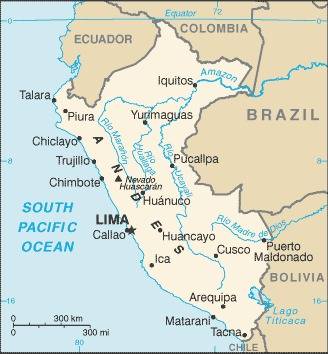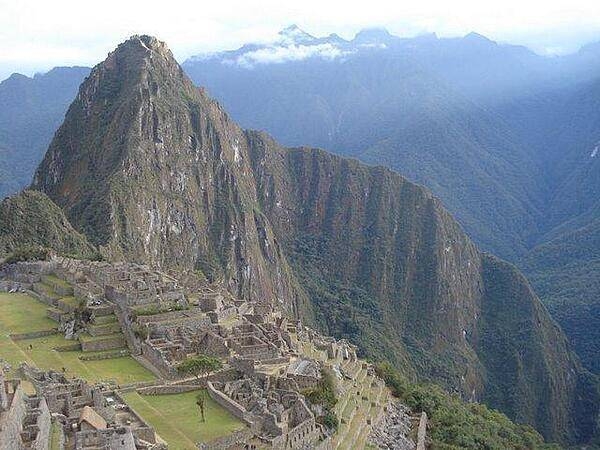29 Peru

Three equal, vertical bands of red (hoist side), white, and red with the coat of arms centered in the white band. The coat of arms features a shield bearing a vicuna (representing fauna), a cinchona tree (the source of quinine, signifying flora), and a yellow cornucopia spilling out coins (denoting mineral wealth). Red recalls blood shed for independence, white symbolizes peace.
Flag courtesy of the CIA World Factbook

Map courtesy of CIA World Factbook

A section of housing is seen in front of Machu Picchu’s Sacred Plaza, with the Intiwatana (Hitching Post of the Sun) above the plaza and the Western Urban Section to its right, where llamas roam.
Photo courtesy of the CIA World Factbook
Government
According to Britannica, Peru’s political history has been punctuated by numerous military coups and changes of constitution. The 1993 Peruvian constitution, which has since been amended several times, decrees a government headed by a president who is popularly elected to a five-year term and serves as chief of state and head of government. The president can be reelected but is prohibited from serving consecutive terms. The president appoints and presides over the Council of Ministers (Cabinet) and is assisted by the president of the Council of Ministers (in effect, the prime minister, who is also appointed by the president) as well as by two popularly elected vice presidents. Legislative power is vested in the unicameral Congress of the Republic, whose members are popularly elected to five-year terms.
For administrative purposes, the country is divided into 25 regions, which are further divided into departments, provinces, and districts. The regional level of government encompasses regions and departments; provinces, districts, and smaller population centers constitute the levels of local government.
The judiciary comprises the Supreme Court and lower courts and tribunals. The Supreme Court has nationwide jurisdiction and hears appeals from lower-court decisions; it also investigates the conduct of lower-court judges. All Supreme Court judges and some judges of lower courts are appointed by the National Council of the Magistracy. A Constitutional Court exists to review any challenges concerning the constitutionality of laws and acts of government. Members of the Constitutional Court are elected by Congress and serve five-year terms.
Civil / National Aviation Authority (CAA/NAA)
With regulatory technical authority at the national level exercised by the General Directorate of Civil Aviation of Peru, it is responsible for regulating, monitoring, supervising, sanctioning, as well as developing strategies to ensure that civil aviation activities and civil air navigation achieve a level of security. acceptable operational.
Airspace
SkyVector – Google Maps – ADS-B Exchange
ICAO countries publish an Aeronautical Information Publication (AIP). This document is divided into three parts: General (GEN), En Route (ENR) and Aerodromes (AD). ENR 1.4 details the types of airspace classes they chose to adopt from classes A through G. Peru AIP (requires a user name and password).
Drone Regulations
Users of remotely piloted aircraft must meet three important requirements. To operate a remotely piloted aircraft (RPA), also known as a drone, it is necessary to meet certain requirements, according to the General Directorate of Civil Aeronautics (DGAC) of the Ministry of Transport and Communications (MTC). In accordance with the provisions of the Complementary Technical Standard (NTC 001-2015), these technological devices are subject to Peruvian aeronautical legislation. That is why any person or organization wishing to fly over a unit of this type must:
1. Register it. The operator of a drone will request a registration card from the Directorate of Certifications and Authorizations of the DGAC, in which he will record the data of the equipment. This document is requested in person at the MTC headquarters (Jr. Zorritos 1203, Cercado de Lima) or at the Citizen Service Centers that the sector has in the regions. This process takes 48 hours.
2. Accredit the pilot. The DGAC will qualify a citizen as a drone operator as long as he has been trained and certified by a Civil Aviation Training Center or an aero-sports institution accredited by the ministry. And, in addition, pass the theoretical evaluation taken by the Aeronautical Licensing Coordination.
3. Request permission to fly over. There is no restriction for overflight in rural areas. However, if you want to manipulate a drone in an urban area, the pilot must request a permit from the MTC in advance. The document must be entered by the parties table -addressed to the DGAC- indicating the date, time and coordinates in which the device will be used.
Compliance with these requirements guarantees the safety of people, prevents interference in the operations of airspace users and damage to private property.
Fact:
The overflight of drones in restricted areas, such as the Government Palace, military areas, airports, archaeological centers and protected natural areas, is prohibited, unless authorized by the corresponding entities.
On this RPAS page you will find a Registry of Remotely Piloted Aircraft Systems – RPAS Companies authorized in Peru.
Ministry of Transport and Communications (MTC):
Everything you need to know to operate a drone
Know the requirements to fly a drone in Peru
Aeronautical knowledge test syllabus
Permits needed to fly a drone in Peru
Advanced Air Mobility (AAM) Regulations & Policies
None found by the author.
However, should you, the reader, happen to stumble across something to the contrary, please email the author at FISHE5CA@erau.edu and you may be mentioned in the ACKNOWLEDGEMENTS section of this book by way of thanks for contributing to this free eBook!
Advanced Air Mobility (AAM) News
Short Essay Questions
Question 1
You have been hired by a Drone Startup Company. Your boss has immediately assigned this job to you.
They need you to prepare a one-page memo detailing the legalities of using a drone at the archaeological site of Machu Picchu, pictured above.
They need you to mention any national laws and local ordinances.
They specifically want to know what airspace you will be operating in and whether or not you need an airspace authorization.
Does it matter whether or not you are a citizen of the country?
Lastly, there is a bonus for you if, as you scroll through this chapter, you find any typos or broken links!
Question 2
Do you need a certificate to fly UAS?
If so, how do you obtain one?
Are there fees associated with this?
If so, how much?
Question 3
May you operate beyond visual line of sight?
If so, what procedures must you follow?
Question 4
Does the country have UAM/AAM laws? If so, describe, citing the exact law.
Question 5
Are you aware of any new laws or policies not mentioned above? If so, describe, citing the exact law or policy.

